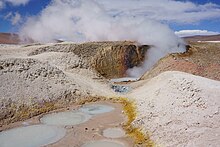
Back داخنة Arabic Фумарола Byelorussian Фумарола Bulgarian ধূম্ররন্ধ্র Bengali/Bangla Fumarola Catalan Fumarola Czech Ffwmarol Welsh Fumarole Danish Fumarole German Φουμαρόλη Greek

A fumarole (or fumerole)[1] is a vent in the surface of the Earth or another rocky planet from which hot volcanic gases and vapors are emitted, without any accompanying liquids or solids. Fumaroles are characteristic of the late stages of volcanic activity, but fumarole activity can also precede a volcanic eruption and has been used for eruption prediction. Most fumaroles die down within a few days or weeks of the end of an eruption, but a few are persistent, lasting for decades or longer. An area containing fumaroles is known as a fumarole field.
The predominant vapor emitted by fumaroles is steam, formed by the circulation of groundwater through heated rock. This is typically accompanied by volcanic gases given off by magma cooling deep below the surface. These volcanic gases include sulfur compounds, such as various sulfur oxides and hydrogen sulfide, and sometimes hydrogen chloride, hydrogen fluoride, and other gases. A fumarole that emits significant sulfur compounds is sometimes called a solfatara.
Fumarole activity can break down rock around the vent, while simultaneously depositing sulfur and other minerals. Valuable hydrothermal mineral deposits can form beneath fumaroles. However, active fumaroles can be a hazard due to their emission of hot, poisonous gases.
- ^ "fumerole – Definition and meaning". Merriam-Webster.com Dictionary. Merriam-Webster. Retrieved 4 June 2023.
© MMXXIII Rich X Search. We shall prevail. All rights reserved. Rich X Search